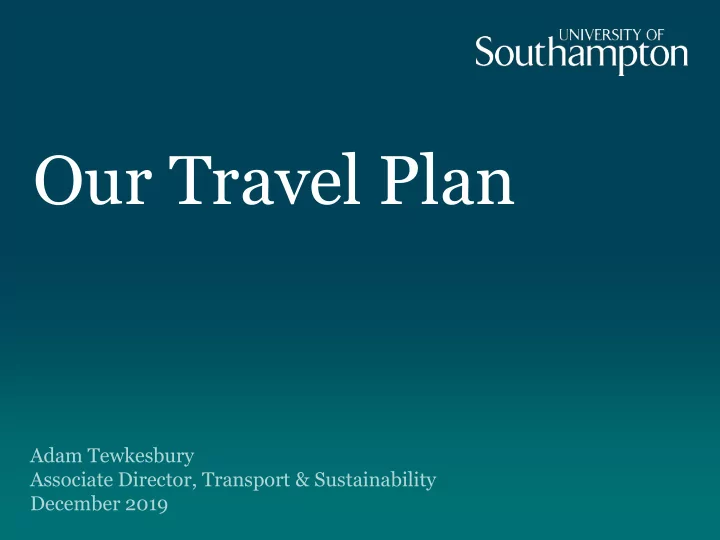

Our Travel Plan Adam Tewkesbury Associate Director, Transport & Sustainability December 2019
Travel Plan History • Adopted in 2010, regular surveys. • Achieved (& exceeded) 2015 targets for modal shift. • Submitted with all University planning applications. • Primarily funded by car parking income. • Has led to successful grant applications for transport funding. • The overall aim of the Travel Plan is to reduce single-occupancy car journeys. 2
Travel Plan 2019 • We met our target for reducing car use by students (3%) • We have made progress towards our target for car use by staff (37% against a 30% target) 3
Walking • + 1.5% (staff) • - 10% (students) • …due to student residential locations ( eg Mayflower Halls) • Increased walking between campuses during the day. Travel Plan measures include: Improvements to pedestrian routes • Accessibility • Improved wayfinding options • Better public realm • 4
Cycling • + 3.1% (staff) • -4.6% (students) • …again due to student residential locations Travel Plan measures include: More, better located cycle storage (Workplace Grant Funding) • Showers on campuses • Bike Dr service (Workplace Grant Funding) • Cycle to work scheme • Competitions and campaigns • Pool bikes (Workplace Grant Funding?) • • 5
Public Transport • Bus: + 3.1% (staff), + 25.9% (students) • Rail: + 2.5% (staff), + 0.6% (students) Travel Plan measures include: Increased routes and frequency on Uni-link • bus network Cross-ticketing with other bus networks • better integration between bus and rail • timetables increased ticketing options • 6
Driving • Car Sharing: -1.9% (staff), -4.5% (students) • Driving alone: -9.3% (staff), - 7.1% (students) Travel Plan measures include: Restrictions on student car parking at Halls of Residence • Increased permit costs • Reduced rates for lower emission vehicles • Facilities for electric vehicle charging • 7
Feedback 8
Focus of the Travel Plan 2020-2030 • Move away from looking at each mode of transport in isolation? • Use alternative KPI’s, reduce reliance on bi -annual surveys? • Consider transport impact in terms of: – Space (making the best use of the space available on our campuses, to improve their feel and accessibility) – Carbon Impact (as we seek to support Southampton’s Green City Charter) – Health Impact (implications of poor air quality, sedentary lifestyles, health & safety implications of travel) 9
Next Steps… • Workshops to shape our Travel Plan priorities. • Align with our Environmental Management System and Sustainability Strategy. • Increase connections with academic research and projects. • Continued close engagement with local authorities, businesses and groups. • Review home locations of staff and students and availability of travel options. • Consider impact of established working practice (e.g. 9-5 working). • Balance business-as-usual travel demand with campus development plans and contractor activity. • Review future changes; Mobility as a Service, electric & autonomous vehicles • Launch of new Travel Plan in Spring 2020. 10
Thank You Adam Tewkesbury a.j.Tewkesbury@soton.ac.uk 02380593828 11
Cost Benefit Analysis 12
One example… 13
Better examples… • Uni-link Bus Operation Costs Benefits Contract cost Student Experience Space requirement (Interchange etc) Passenger income Management & administration Staff commuting option Supports Travel Plan objectives Reputational benefit Supports University events 14
Better examples… • Uni-Cycle Bike Recycling Project Costs Benefits Administration (tagging, record Reduced waste keeping, event management) Collection & Storage Frees up cycle storage (abandoned bikes) Repair costs Positive promotional value Limited income (objective to break Use as student engagement tool even on operational costs) Supports Travel Plan objectives 15
Workshop • As a small group, discuss the key costs and benefits of providing a Bike Dr service at your place of work. • (please feel free to agree an alternative example if you prefer!) • Report back; on the basis of your assessment, would you recommend that you provide the service? 16
Recommend
More recommend